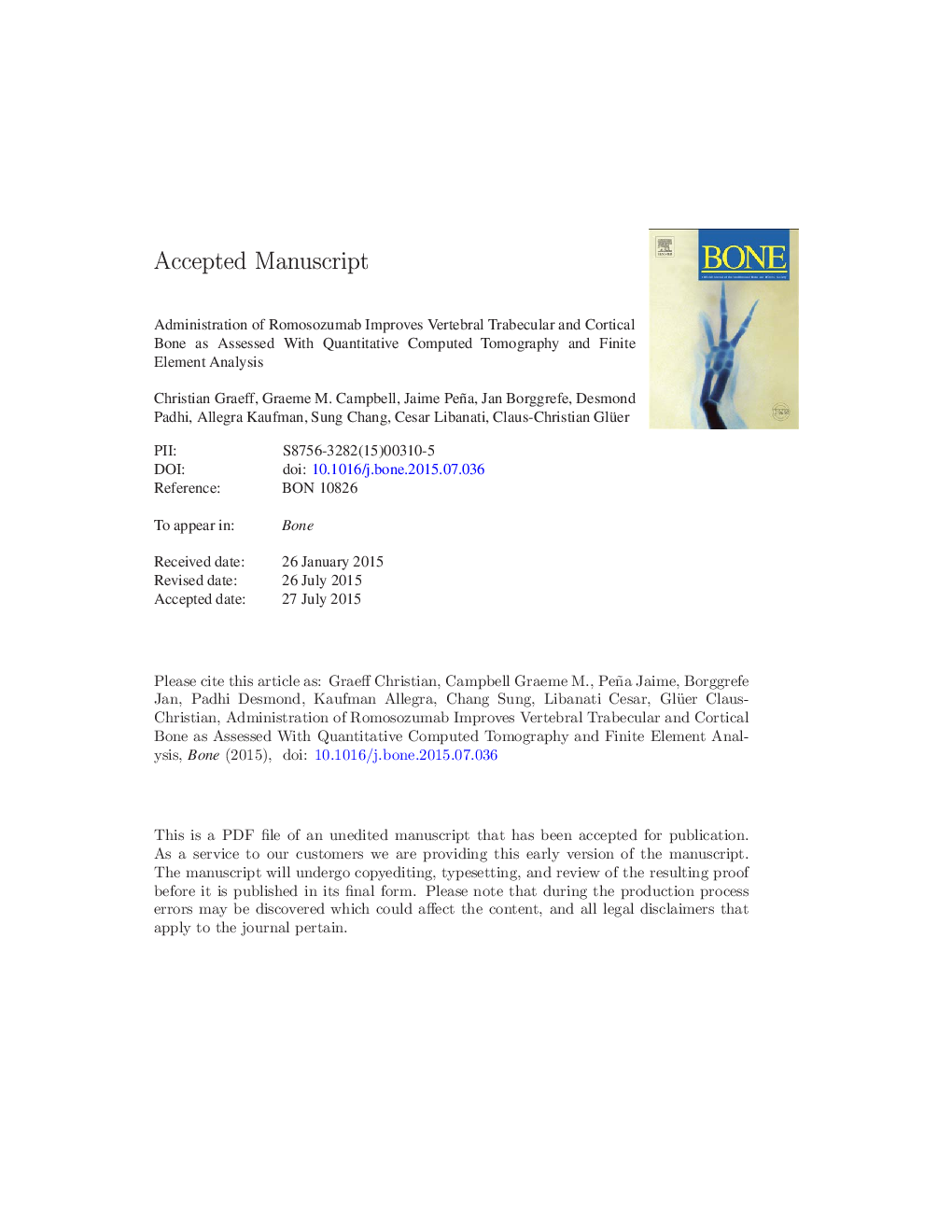| کد مقاله | کد نشریه | سال انتشار | مقاله انگلیسی | نسخه تمام متن |
|---|---|---|---|---|
| 5889297 | 1568138 | 2015 | 25 صفحه PDF | دانلود رایگان |
عنوان انگلیسی مقاله ISI
Administration of romosozumab improves vertebral trabecular and cortical bone as assessed with quantitative computed tomography and finite element analysis
ترجمه فارسی عنوان
مدیریت راموسوزوماب باعث بهبود استخوان ترابکال و کورتکس مهره ای می شود که به وسیله آن با استفاده از تست های کامپیوتری و تجزیه و تحلیل عناصر محدود
دانلود مقاله + سفارش ترجمه
دانلود مقاله ISI انگلیسی
رایگان برای ایرانیان
کلمات کلیدی
BMDQCTAPPCt.ThTb.SpDXAaBMDQ2WQ4WBV/TV - BV / TVApparent - آشکارSclerostin - اسکلروستینFinite element - المان محدودstandard deviation - انحراف معیارBone mineral density - تراکم معدنی استخوانAreal bone mineral density - تراکم معدنی استخوان منطقهQuantitative computed tomography - توموگرافی کامپیوتری کمیtrabecular separation - جداسازی ترابکولارdual-energy X-ray absorptiometry - جذب اندازه گیری اشعه ایکس دوگانه انرژیstandard error - خطای استانداردRomosozumab - رموزوموآبcortical thickness - ضخامت قشرBone volume fraction - کسر حجم استخوان
موضوعات مرتبط
علوم زیستی و بیوفناوری
بیوشیمی، ژنتیک و زیست شناسی مولکولی
زیست شناسی تکاملی
چکیده انگلیسی
Romosozumab inhibits sclerostin, thereby increasing bone formation and decreasing bone resorption. This dual effect of romosozumab leads to rapid and substantial increases in areal bone mineral density (aBMD) as measured by dual-energy X-ray absorptiometry (DXA). In a phase 1b, randomized, double-blind, placebo-controlled study, romosozumab or placebo was administered to 32 women and 16 men with low aBMD for 3 months, with a further 3-month follow-up: women received six doses of 1 or 2 mg/kg every 2 weeks (Q2W) or three doses of 2 or 3 mg/kg every 4 weeks (Q4W); men received 1 mg/kg Q2W or 3 mg/kg Q4W. Quantitative computed tomography (QCT) scans at lumbar (L1-2) vertebrae and high-resolution QCT (HR-QCT) scans at thoracic vertebra (T12) were analyzed in a subset of subjects at baseline, month 3, and month 6. The QCT subset included 24 romosozumab and 9 placebo subjects and the HR-QCT subset included 11 romosozumab and 3 placebo subjects. The analyses pooled the romosozumab doses. Linear finite element modeling of bone stiffness was performed. Compared with placebo, the romosozumab group showed improvements at month 3 for trabecular BMD by QCT and HR-QCT, HR-QCT trabecular bone volume fraction (BV/TV) and separation, density-weighted cortical thickness, and QCT stiffness (all p < 0.05). At month 6, improvements from baseline were observed in QCT trabecular BMD and stiffness, and in HR-QCT BMD, trabecular BV/TV and separation, density-weighted cortical thickness, and stiffness in the romosozumab group (all p < 0.05 compared with placebo). The mean (SE) increase in HR-QCT stiffness with romosozumab from baseline was 26.9% ± 6.8% and 35.0% ± 6.8% at months 3 and 6, respectively; subjects administered placebo had changes of â 2.7% ± 13.4% and â 6.4% ± 13.4%, respectively. In conclusion, romosozumab administered for 3 months resulted in rapid and large improvements in trabecular and cortical bone mass and structure as well as whole bone stiffness, which continued 3 months after the last romosozumab dose.
ناشر
Database: Elsevier - ScienceDirect (ساینس دایرکت)
Journal: Bone - Volume 81, December 2015, Pages 364-369
Journal: Bone - Volume 81, December 2015, Pages 364-369
نویسندگان
Christian Graeff, Graeme M. Campbell, Jaime Peña, Jan Borggrefe, Desmond Padhi, Allegra Kaufman, Sung Chang, Cesar Libanati, Claus-Christian Glüer,
